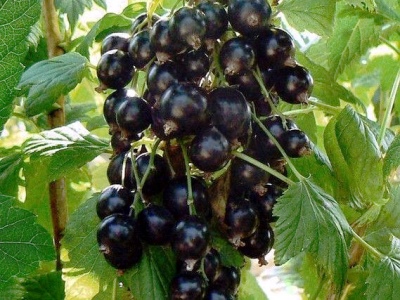
- Authors: A. G. Voluznev, N. A. Zazulina, G. P. Rainchikova (RNPD Unitary Enterprise "Institute of Fruit Growing")
- Appeared when crossing: Peacock x Pilot
- Year of approval: 1998
- Ripening terms: medium late ripening
- Growth type: vigorous
- Yield: high
- Appointment: universal
- Berry weight, g: 1,3-1,4
- Tasting assessment: 4.2 points
- Escapes: straight, light brown
Black currant Katyusha is a popular variety of Belarusian selection, approved for use more than 20 years ago. He is especially fond of gardeners for large-fruited, versatility of use. The variety is suitable for cultivation on farms, suitable for mechanized harvesting.
Description of the variety
Vigorous bushes are formed in the Katyusha currant. Shoots are straight, slightly spreading, colored in a light brown shade. The leaves are wrinkled, rather large, but the crown is not thickened, allowing sunlight to pass through. The brush is long, with not very densely spaced berries.
Characteristics of berries
Katyusha has large fruits with black skin and an unusual pear-shaped shape. The average weight of each reaches 1.3-1.4 g. The skin is shiny, dense, keeps its shape well, not prone to cracking.
Taste qualities
The berries of the Katyusha currant are sweet and sour, with a pleasant aroma. The pulp is very juicy, with few seeds. The tasting score of the fruit exceeds 4.2 points.
Ripening and fruiting
The variety is medium late, it enters the fruiting period in 215 days.

Yield
The average collection rate for this variety is 62 kg / ha. The maximum yield can reach 11 t / ha.
Growing regions
In the Russian Federation, the variety is zoned for cultivation in the Middle Volga, the Urals, the North Caucasus, in the North-West region.
Self-fertility and the need for pollinators
Katyusha is a highly self-fertile currant, pollinates up to 60% of flowers. It is possible to increase these indicators by planting next to one of its parent varieties - Pilot Alexander Mamkin or Pavlinka. Other currant bushes that bloom in May-June are also suitable.
Landing
It is customary to plant Katyusha currant bushes in well-lit places with light shading during the day. Areas along hedges work well. A shallow root system will not damage your fence or home foundation. The soil should be well-drained, rich in humus, but not sandy, and free from excess clay. Optimum acidity values range from 6 to 6.5 pH.
Plants with an open root system are best planted in autumn, container plants at any time during the warm period. Each seedling should have 3-4 full-fledged shoots with buds. It is not necessary to prepare deep pits for currants, but it is better to place the bushes at a distance of at least 1.5 m from each other.
Dig holes in advance, about a month in advance. The bottom is lined with a 5 cm drainage layer, 10 kg of rotted manure, 5 kg of compost, 75 double superphosphate are added to the excavated soil. Everything gets mixed up. The wells are filled to 2/3 of the volume, watered abundantly.
When planting, the soil in the hole is loosened, a mound is built from it. A plant is installed on it, with a stem slope of 45 degrees. It goes a little deeper - 50-100 mm from the edge of the hole. Then the hole must be filled with earth to the brim, compacted, and watered abundantly. After planting, shoots are cut to 2 buds from ground level, the root area is mulched.

Growing and care
Within 21 days after planting, Katyusha currant bushes are watered abundantly every 3 days. In the future, the frequency of moisture application is reduced to 1 time per week. Loosening and weeding also have a beneficial effect on the growth and development of seedlings. In the fall, for 2 years from the moment of planting, it will be useful to apply a layer of manure or compost under the root on top of the soil. When growth slows down, you can use stimulants - "Kemira-Lux" or other similar formulations.




Disease and pest resistance
The variety has a high immune defense against powdery mildew. Kidney mites are moderately affected.

Currant is one of the most favorite crops of gardeners, it can be found on almost any personal plot. In order for the currant berries to be tasty and large, and the bush itself to be healthy and strong, you should properly care for, treat and protect the plant from harmful insects. It is important to recognize the signs of the disease in a timely manner and begin treatment in the early stages of plant damage.
Resistance to adverse climatic conditions
The variety is winter-hardy. Leaves may turn yellow in bright sun. The variety is sensitive to strong through wind, for planting it is better to choose areas protected from it.

Review overview
The Katyusha currant receives the most rave reviews from amateur gardeners in Russia and Belarus. It is noted that the berries on the bushes do not crumble, fruiting is always abundant, regardless of the weather. The bushes are distinguished by good growth intensity, they do not need to be necessarily placed nearby pollinators. The taste of berries is especially praised - rich, sweet, and the leaves are collected for making tea and useful broths, mentioning the special aroma of greens in this particular variety.
Among other advantages of Katyusha, gardeners emphasize its resistance to various diseases. It is above average, and in frosty winters the plants are also pretty well preserved, quickly gaining green growth in spring.In agrotechnical measures, summer residents are advised to adhere to the principles of moderation. You should not be zealous with watering, planting on poorly permeable clay soils.
Summer residents have not revealed any serious shortcomings in this variety. They consider a slight drawback to the somewhat excessive spreading of the bush, which differs from that declared by the originator, as well as its need for thinning. In the absence of these measures, the berries may become smaller.









































































